University of South Australia: MPM Procurement and Contract Report
VerifiedAdded on 2023/03/20
|23
|5706
|75
Report
AI Summary
This report, prepared by students from the University of South Australia, focuses on the MPM Procurement and Contract Management of the Oaklands Crossing Grade Separation Project. It delves into various aspects of the procurement process, including different methods of tendering such as open, selective, and negotiated tendering, along with their respective advantages and disadvantages. The report also explores various contract types like traditional, design and build, and non-traditional or management contracts, outlining their characteristics and applications. Furthermore, it examines the tender evaluation process, prequalification, procedural fairness, and the legal implications of procurement practices. While the report acknowledges limitations due to unavailable tender documents, it provides a comprehensive overview of procurement and contract management principles in the context of the Oaks Crossing project, including the importance of understanding specifications and achieving transparency throughout the process. The report concludes with a summary of the key findings and references relevant literature.
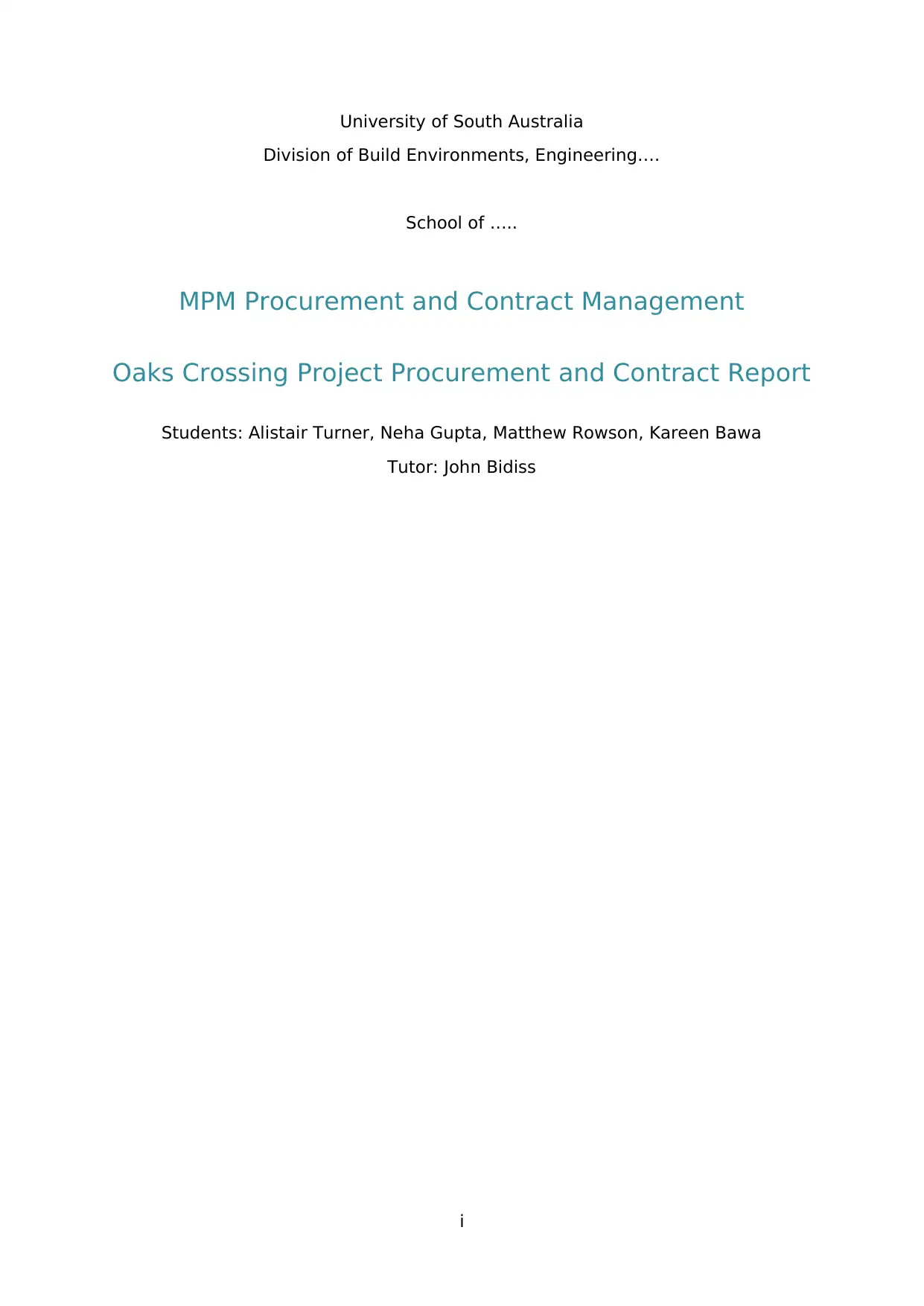
University of South Australia
Division of Build Environments, Engineering….
School of …..
MPM Procurement and Contract Management
Oaks Crossing Project Procurement and Contract Report
Students: Alistair Turner, Neha Gupta, Matthew Rowson, Kareen Bawa
Tutor: John Bidiss
i
Division of Build Environments, Engineering….
School of …..
MPM Procurement and Contract Management
Oaks Crossing Project Procurement and Contract Report
Students: Alistair Turner, Neha Gupta, Matthew Rowson, Kareen Bawa
Tutor: John Bidiss
i
Paraphrase This Document
Need a fresh take? Get an instant paraphrase of this document with our AI Paraphraser

Disclaimer
During the research phase of this assignment, the students contacted various
sources to gain access to the tender documents of selected projects.
Unfortunately, due to disbandment of procurement teams, required permissions
or unavailable key personnel, these documents have not been made available to
include them in this report.
Some assumptions have been made as to what would be expected within the
tender documents of the selected project. Where this has occurred, it has been
documented and can be found in the table at Appendix A.
ii
During the research phase of this assignment, the students contacted various
sources to gain access to the tender documents of selected projects.
Unfortunately, due to disbandment of procurement teams, required permissions
or unavailable key personnel, these documents have not been made available to
include them in this report.
Some assumptions have been made as to what would be expected within the
tender documents of the selected project. Where this has occurred, it has been
documented and can be found in the table at Appendix A.
ii
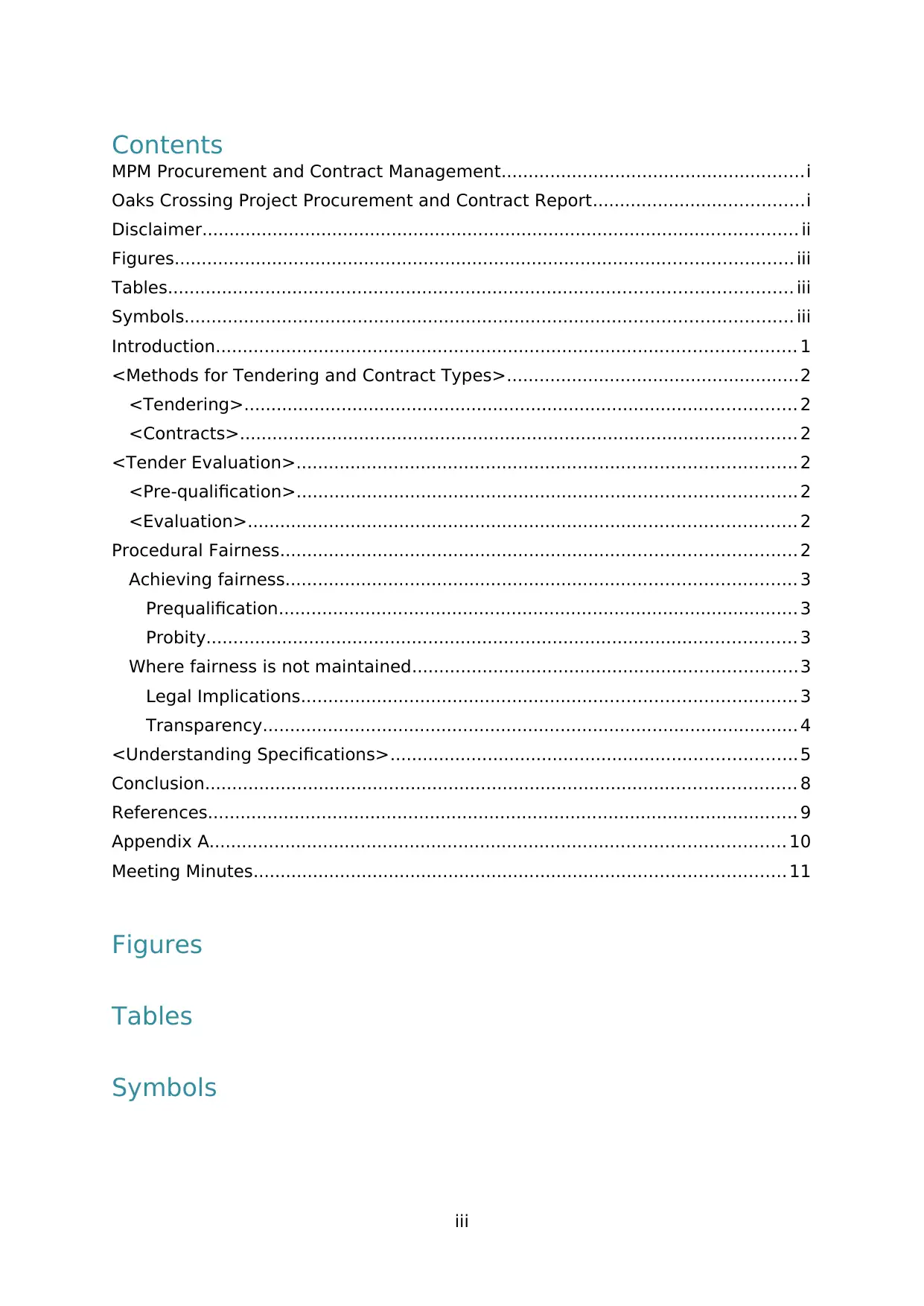
Contents
MPM Procurement and Contract Management........................................................i
Oaks Crossing Project Procurement and Contract Report.......................................i
Disclaimer.............................................................................................................. ii
Figures.................................................................................................................. iii
Tables................................................................................................................... iii
Symbols................................................................................................................ iii
Introduction........................................................................................................... 1
<Methods for Tendering and Contract Types>......................................................2
<Tendering>...................................................................................................... 2
<Contracts>....................................................................................................... 2
<Tender Evaluation>............................................................................................ 2
<Pre-qualification>............................................................................................ 2
<Evaluation>..................................................................................................... 2
Procedural Fairness............................................................................................... 2
Achieving fairness.............................................................................................. 3
Prequalification................................................................................................ 3
Probity............................................................................................................. 3
Where fairness is not maintained.......................................................................3
Legal Implications........................................................................................... 3
Transparency................................................................................................... 4
<Understanding Specifications>...........................................................................5
Conclusion............................................................................................................. 8
References............................................................................................................. 9
Appendix A.......................................................................................................... 10
Meeting Minutes.................................................................................................. 11
Figures
Tables
Symbols
iii
MPM Procurement and Contract Management........................................................i
Oaks Crossing Project Procurement and Contract Report.......................................i
Disclaimer.............................................................................................................. ii
Figures.................................................................................................................. iii
Tables................................................................................................................... iii
Symbols................................................................................................................ iii
Introduction........................................................................................................... 1
<Methods for Tendering and Contract Types>......................................................2
<Tendering>...................................................................................................... 2
<Contracts>....................................................................................................... 2
<Tender Evaluation>............................................................................................ 2
<Pre-qualification>............................................................................................ 2
<Evaluation>..................................................................................................... 2
Procedural Fairness............................................................................................... 2
Achieving fairness.............................................................................................. 3
Prequalification................................................................................................ 3
Probity............................................................................................................. 3
Where fairness is not maintained.......................................................................3
Legal Implications........................................................................................... 3
Transparency................................................................................................... 4
<Understanding Specifications>...........................................................................5
Conclusion............................................................................................................. 8
References............................................................................................................. 9
Appendix A.......................................................................................................... 10
Meeting Minutes.................................................................................................. 11
Figures
Tables
Symbols
iii
⊘ This is a preview!⊘
Do you want full access?
Subscribe today to unlock all pages.

Trusted by 1+ million students worldwide

Introduction
This report focuses on the Oaklands Crossing Grade Separation Project.
1
This report focuses on the Oaklands Crossing Grade Separation Project.
1
Paraphrase This Document
Need a fresh take? Get an instant paraphrase of this document with our AI Paraphraser
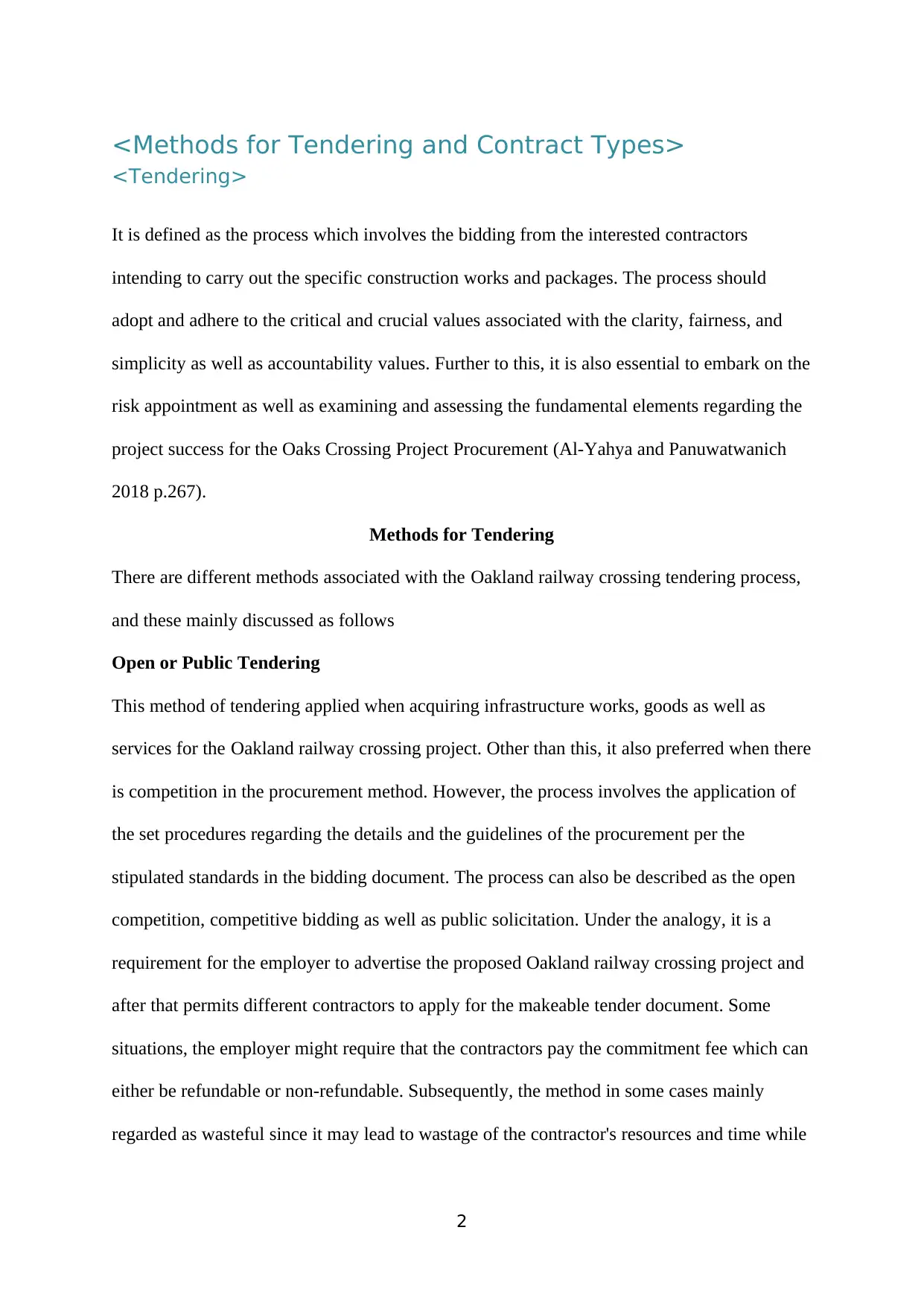
<Methods for Tendering and Contract Types>
<Tendering>
It is defined as the process which involves the bidding from the interested contractors
intending to carry out the specific construction works and packages. The process should
adopt and adhere to the critical and crucial values associated with the clarity, fairness, and
simplicity as well as accountability values. Further to this, it is also essential to embark on the
risk appointment as well as examining and assessing the fundamental elements regarding the
project success for the Oaks Crossing Project Procurement (Al-Yahya and Panuwatwanich
2018 p.267).
Methods for Tendering
There are different methods associated with the Oakland railway crossing tendering process,
and these mainly discussed as follows
Open or Public Tendering
This method of tendering applied when acquiring infrastructure works, goods as well as
services for the Oakland railway crossing project. Other than this, it also preferred when there
is competition in the procurement method. However, the process involves the application of
the set procedures regarding the details and the guidelines of the procurement per the
stipulated standards in the bidding document. The process can also be described as the open
competition, competitive bidding as well as public solicitation. Under the analogy, it is a
requirement for the employer to advertise the proposed Oakland railway crossing project and
after that permits different contractors to apply for the makeable tender document. Some
situations, the employer might require that the contractors pay the commitment fee which can
either be refundable or non-refundable. Subsequently, the method in some cases mainly
regarded as wasteful since it may lead to wastage of the contractor's resources and time while
2
<Tendering>
It is defined as the process which involves the bidding from the interested contractors
intending to carry out the specific construction works and packages. The process should
adopt and adhere to the critical and crucial values associated with the clarity, fairness, and
simplicity as well as accountability values. Further to this, it is also essential to embark on the
risk appointment as well as examining and assessing the fundamental elements regarding the
project success for the Oaks Crossing Project Procurement (Al-Yahya and Panuwatwanich
2018 p.267).
Methods for Tendering
There are different methods associated with the Oakland railway crossing tendering process,
and these mainly discussed as follows
Open or Public Tendering
This method of tendering applied when acquiring infrastructure works, goods as well as
services for the Oakland railway crossing project. Other than this, it also preferred when there
is competition in the procurement method. However, the process involves the application of
the set procedures regarding the details and the guidelines of the procurement per the
stipulated standards in the bidding document. The process can also be described as the open
competition, competitive bidding as well as public solicitation. Under the analogy, it is a
requirement for the employer to advertise the proposed Oakland railway crossing project and
after that permits different contractors to apply for the makeable tender document. Some
situations, the employer might require that the contractors pay the commitment fee which can
either be refundable or non-refundable. Subsequently, the method in some cases mainly
regarded as wasteful since it may lead to wastage of the contractor's resources and time while
2
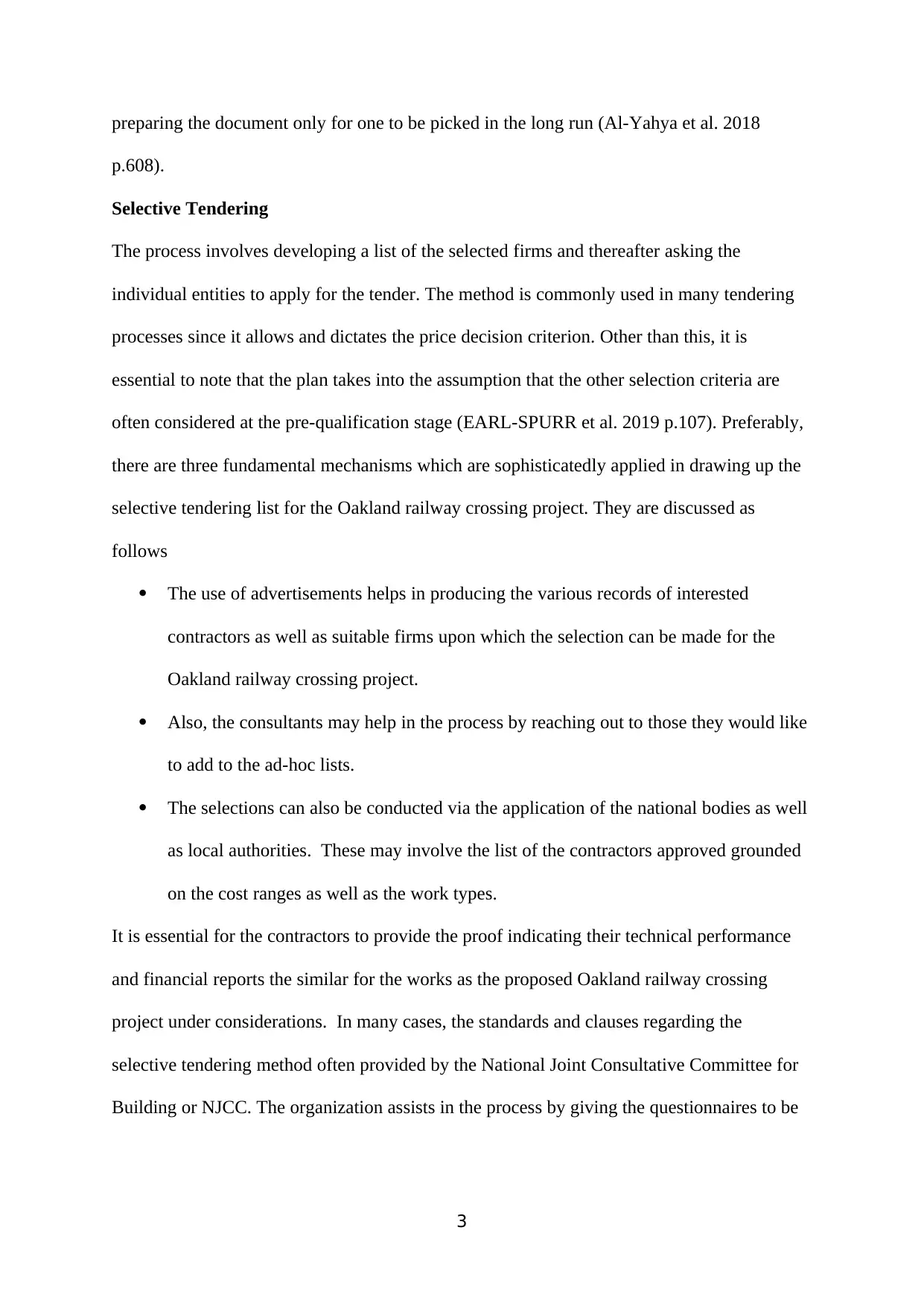
preparing the document only for one to be picked in the long run (Al-Yahya et al. 2018
p.608).
Selective Tendering
The process involves developing a list of the selected firms and thereafter asking the
individual entities to apply for the tender. The method is commonly used in many tendering
processes since it allows and dictates the price decision criterion. Other than this, it is
essential to note that the plan takes into the assumption that the other selection criteria are
often considered at the pre-qualification stage (EARL-SPURR et al. 2019 p.107). Preferably,
there are three fundamental mechanisms which are sophisticatedly applied in drawing up the
selective tendering list for the Oakland railway crossing project. They are discussed as
follows
The use of advertisements helps in producing the various records of interested
contractors as well as suitable firms upon which the selection can be made for the
Oakland railway crossing project.
Also, the consultants may help in the process by reaching out to those they would like
to add to the ad-hoc lists.
The selections can also be conducted via the application of the national bodies as well
as local authorities. These may involve the list of the contractors approved grounded
on the cost ranges as well as the work types.
It is essential for the contractors to provide the proof indicating their technical performance
and financial reports the similar for the works as the proposed Oakland railway crossing
project under considerations. In many cases, the standards and clauses regarding the
selective tendering method often provided by the National Joint Consultative Committee for
Building or NJCC. The organization assists in the process by giving the questionnaires to be
3
p.608).
Selective Tendering
The process involves developing a list of the selected firms and thereafter asking the
individual entities to apply for the tender. The method is commonly used in many tendering
processes since it allows and dictates the price decision criterion. Other than this, it is
essential to note that the plan takes into the assumption that the other selection criteria are
often considered at the pre-qualification stage (EARL-SPURR et al. 2019 p.107). Preferably,
there are three fundamental mechanisms which are sophisticatedly applied in drawing up the
selective tendering list for the Oakland railway crossing project. They are discussed as
follows
The use of advertisements helps in producing the various records of interested
contractors as well as suitable firms upon which the selection can be made for the
Oakland railway crossing project.
Also, the consultants may help in the process by reaching out to those they would like
to add to the ad-hoc lists.
The selections can also be conducted via the application of the national bodies as well
as local authorities. These may involve the list of the contractors approved grounded
on the cost ranges as well as the work types.
It is essential for the contractors to provide the proof indicating their technical performance
and financial reports the similar for the works as the proposed Oakland railway crossing
project under considerations. In many cases, the standards and clauses regarding the
selective tendering method often provided by the National Joint Consultative Committee for
Building or NJCC. The organization assists in the process by giving the questionnaires to be
3
⊘ This is a preview!⊘
Do you want full access?
Subscribe today to unlock all pages.

Trusted by 1+ million students worldwide
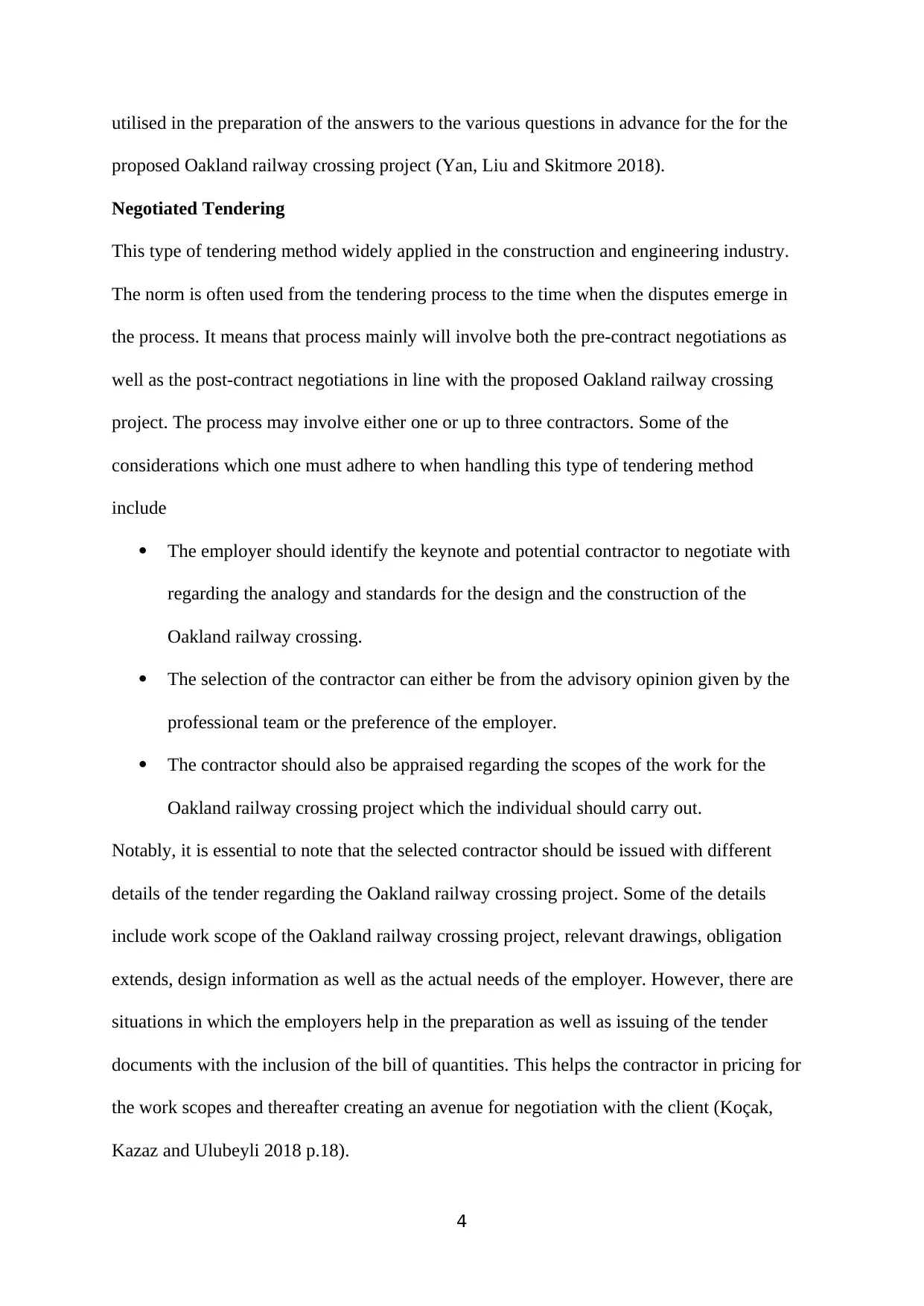
utilised in the preparation of the answers to the various questions in advance for the for the
proposed Oakland railway crossing project (Yan, Liu and Skitmore 2018).
Negotiated Tendering
This type of tendering method widely applied in the construction and engineering industry.
The norm is often used from the tendering process to the time when the disputes emerge in
the process. It means that process mainly will involve both the pre-contract negotiations as
well as the post-contract negotiations in line with the proposed Oakland railway crossing
project. The process may involve either one or up to three contractors. Some of the
considerations which one must adhere to when handling this type of tendering method
include
The employer should identify the keynote and potential contractor to negotiate with
regarding the analogy and standards for the design and the construction of the
Oakland railway crossing.
The selection of the contractor can either be from the advisory opinion given by the
professional team or the preference of the employer.
The contractor should also be appraised regarding the scopes of the work for the
Oakland railway crossing project which the individual should carry out.
Notably, it is essential to note that the selected contractor should be issued with different
details of the tender regarding the Oakland railway crossing project. Some of the details
include work scope of the Oakland railway crossing project, relevant drawings, obligation
extends, design information as well as the actual needs of the employer. However, there are
situations in which the employers help in the preparation as well as issuing of the tender
documents with the inclusion of the bill of quantities. This helps the contractor in pricing for
the work scopes and thereafter creating an avenue for negotiation with the client (Koçak,
Kazaz and Ulubeyli 2018 p.18).
4
proposed Oakland railway crossing project (Yan, Liu and Skitmore 2018).
Negotiated Tendering
This type of tendering method widely applied in the construction and engineering industry.
The norm is often used from the tendering process to the time when the disputes emerge in
the process. It means that process mainly will involve both the pre-contract negotiations as
well as the post-contract negotiations in line with the proposed Oakland railway crossing
project. The process may involve either one or up to three contractors. Some of the
considerations which one must adhere to when handling this type of tendering method
include
The employer should identify the keynote and potential contractor to negotiate with
regarding the analogy and standards for the design and the construction of the
Oakland railway crossing.
The selection of the contractor can either be from the advisory opinion given by the
professional team or the preference of the employer.
The contractor should also be appraised regarding the scopes of the work for the
Oakland railway crossing project which the individual should carry out.
Notably, it is essential to note that the selected contractor should be issued with different
details of the tender regarding the Oakland railway crossing project. Some of the details
include work scope of the Oakland railway crossing project, relevant drawings, obligation
extends, design information as well as the actual needs of the employer. However, there are
situations in which the employers help in the preparation as well as issuing of the tender
documents with the inclusion of the bill of quantities. This helps the contractor in pricing for
the work scopes and thereafter creating an avenue for negotiation with the client (Koçak,
Kazaz and Ulubeyli 2018 p.18).
4
Paraphrase This Document
Need a fresh take? Get an instant paraphrase of this document with our AI Paraphraser

<Contracts>
The contract type is defined as the term utilised in describing the significant differences
which often exists in the contract form or structure. The norm may include risk amounts as
well as the compensation arrangements. Other the other hand, it is important to note that there
are different forms of contracts. However, the Federal government contracts are
sophisticatedly divided into two amicable forms which include cost-reimbursement and
fixed-price (Urquhart and Whyte 2018 p.369).
Contract Types
There are different contract types which one can identify and discuss in line with the
tendering and procurement as far as the for the Oakland railway crossing project is
concerned. They are considered as follows
Traditional Contract
These contract types have a decisive keynote in which the Oakland railway crossing project
works will be divided between the contractor and the consultant. The consultants mostly deal
with the design works of the railway crossing whereas the contractors are often mandated
with the construction of the proposed Oakland railway crossing project. In this contract type,
the consultant acts as the sole client and therefore administers all the roles in the contract on
behalf of the employer. Also, it is essential to note that the majority of the risks are passed to
the parametric contractors as well as sub-contractors as far as the Oakland railway crossing
project is concerned. The traditional contract depicts on the analogy of the ‘sort it out latter.’
This relates that time, costs and other emerging problems are often left and dealt with at the
end of the Oakland railway crossing project. Also, it is important to articulate that design and
construction overlapping is not encouraged at all stages for the railway crossing as per the
standards of Australia (Smith 2017).
Design and Build Contracts
5
The contract type is defined as the term utilised in describing the significant differences
which often exists in the contract form or structure. The norm may include risk amounts as
well as the compensation arrangements. Other the other hand, it is important to note that there
are different forms of contracts. However, the Federal government contracts are
sophisticatedly divided into two amicable forms which include cost-reimbursement and
fixed-price (Urquhart and Whyte 2018 p.369).
Contract Types
There are different contract types which one can identify and discuss in line with the
tendering and procurement as far as the for the Oakland railway crossing project is
concerned. They are considered as follows
Traditional Contract
These contract types have a decisive keynote in which the Oakland railway crossing project
works will be divided between the contractor and the consultant. The consultants mostly deal
with the design works of the railway crossing whereas the contractors are often mandated
with the construction of the proposed Oakland railway crossing project. In this contract type,
the consultant acts as the sole client and therefore administers all the roles in the contract on
behalf of the employer. Also, it is essential to note that the majority of the risks are passed to
the parametric contractors as well as sub-contractors as far as the Oakland railway crossing
project is concerned. The traditional contract depicts on the analogy of the ‘sort it out latter.’
This relates that time, costs and other emerging problems are often left and dealt with at the
end of the Oakland railway crossing project. Also, it is important to articulate that design and
construction overlapping is not encouraged at all stages for the railway crossing as per the
standards of Australia (Smith 2017).
Design and Build Contracts
5
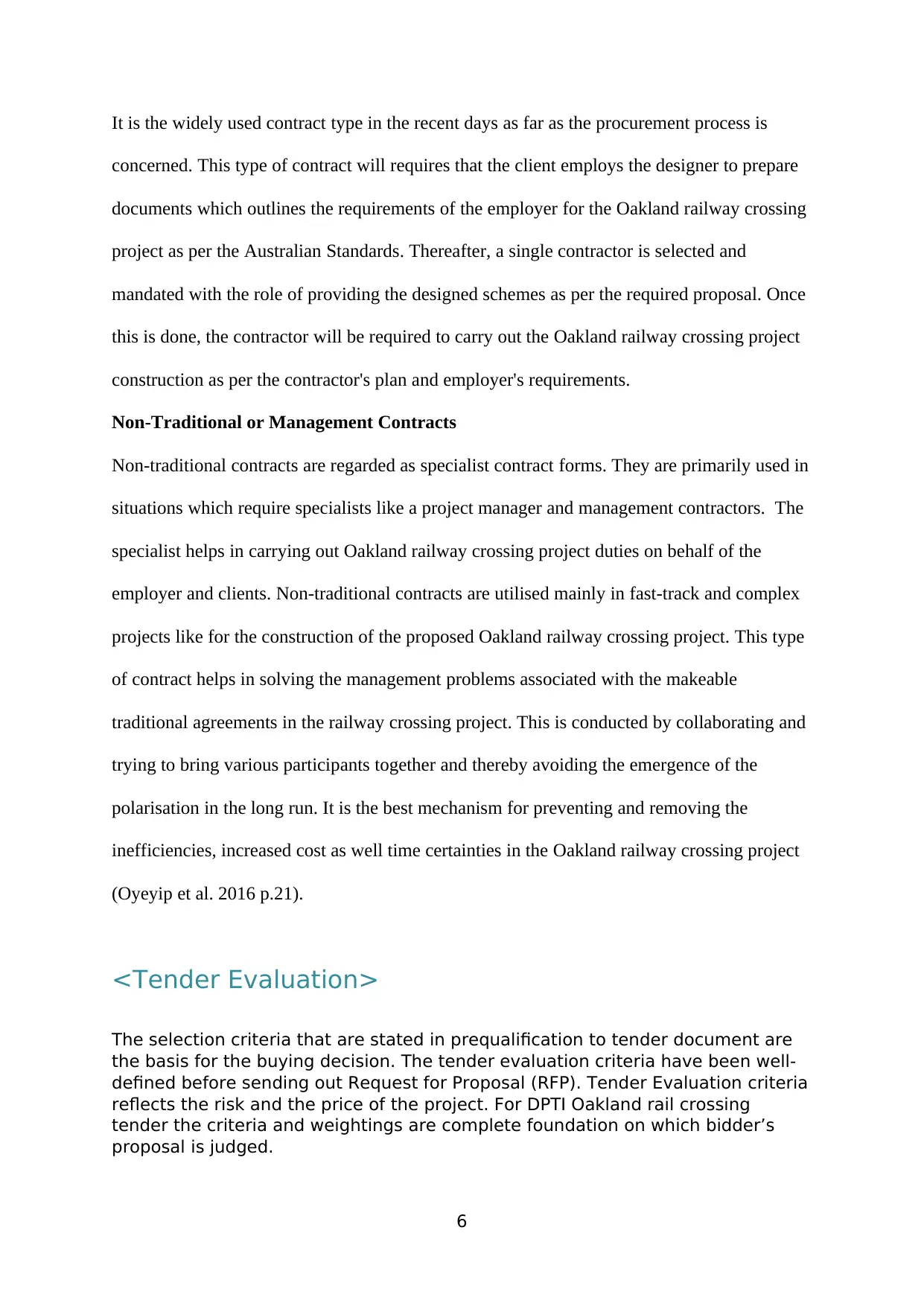
It is the widely used contract type in the recent days as far as the procurement process is
concerned. This type of contract will requires that the client employs the designer to prepare
documents which outlines the requirements of the employer for the Oakland railway crossing
project as per the Australian Standards. Thereafter, a single contractor is selected and
mandated with the role of providing the designed schemes as per the required proposal. Once
this is done, the contractor will be required to carry out the Oakland railway crossing project
construction as per the contractor's plan and employer's requirements.
Non-Traditional or Management Contracts
Non-traditional contracts are regarded as specialist contract forms. They are primarily used in
situations which require specialists like a project manager and management contractors. The
specialist helps in carrying out Oakland railway crossing project duties on behalf of the
employer and clients. Non-traditional contracts are utilised mainly in fast-track and complex
projects like for the construction of the proposed Oakland railway crossing project. This type
of contract helps in solving the management problems associated with the makeable
traditional agreements in the railway crossing project. This is conducted by collaborating and
trying to bring various participants together and thereby avoiding the emergence of the
polarisation in the long run. It is the best mechanism for preventing and removing the
inefficiencies, increased cost as well time certainties in the Oakland railway crossing project
(Oyeyip et al. 2016 p.21).
<Tender Evaluation>
The selection criteria that are stated in prequalification to tender document are
the basis for the buying decision. The tender evaluation criteria have been well-
defined before sending out Request for Proposal (RFP). Tender Evaluation criteria
reflects the risk and the price of the project. For DPTI Oakland rail crossing
tender the criteria and weightings are complete foundation on which bidder’s
proposal is judged.
6
concerned. This type of contract will requires that the client employs the designer to prepare
documents which outlines the requirements of the employer for the Oakland railway crossing
project as per the Australian Standards. Thereafter, a single contractor is selected and
mandated with the role of providing the designed schemes as per the required proposal. Once
this is done, the contractor will be required to carry out the Oakland railway crossing project
construction as per the contractor's plan and employer's requirements.
Non-Traditional or Management Contracts
Non-traditional contracts are regarded as specialist contract forms. They are primarily used in
situations which require specialists like a project manager and management contractors. The
specialist helps in carrying out Oakland railway crossing project duties on behalf of the
employer and clients. Non-traditional contracts are utilised mainly in fast-track and complex
projects like for the construction of the proposed Oakland railway crossing project. This type
of contract helps in solving the management problems associated with the makeable
traditional agreements in the railway crossing project. This is conducted by collaborating and
trying to bring various participants together and thereby avoiding the emergence of the
polarisation in the long run. It is the best mechanism for preventing and removing the
inefficiencies, increased cost as well time certainties in the Oakland railway crossing project
(Oyeyip et al. 2016 p.21).
<Tender Evaluation>
The selection criteria that are stated in prequalification to tender document are
the basis for the buying decision. The tender evaluation criteria have been well-
defined before sending out Request for Proposal (RFP). Tender Evaluation criteria
reflects the risk and the price of the project. For DPTI Oakland rail crossing
tender the criteria and weightings are complete foundation on which bidder’s
proposal is judged.
6
⊘ This is a preview!⊘
Do you want full access?
Subscribe today to unlock all pages.

Trusted by 1+ million students worldwide
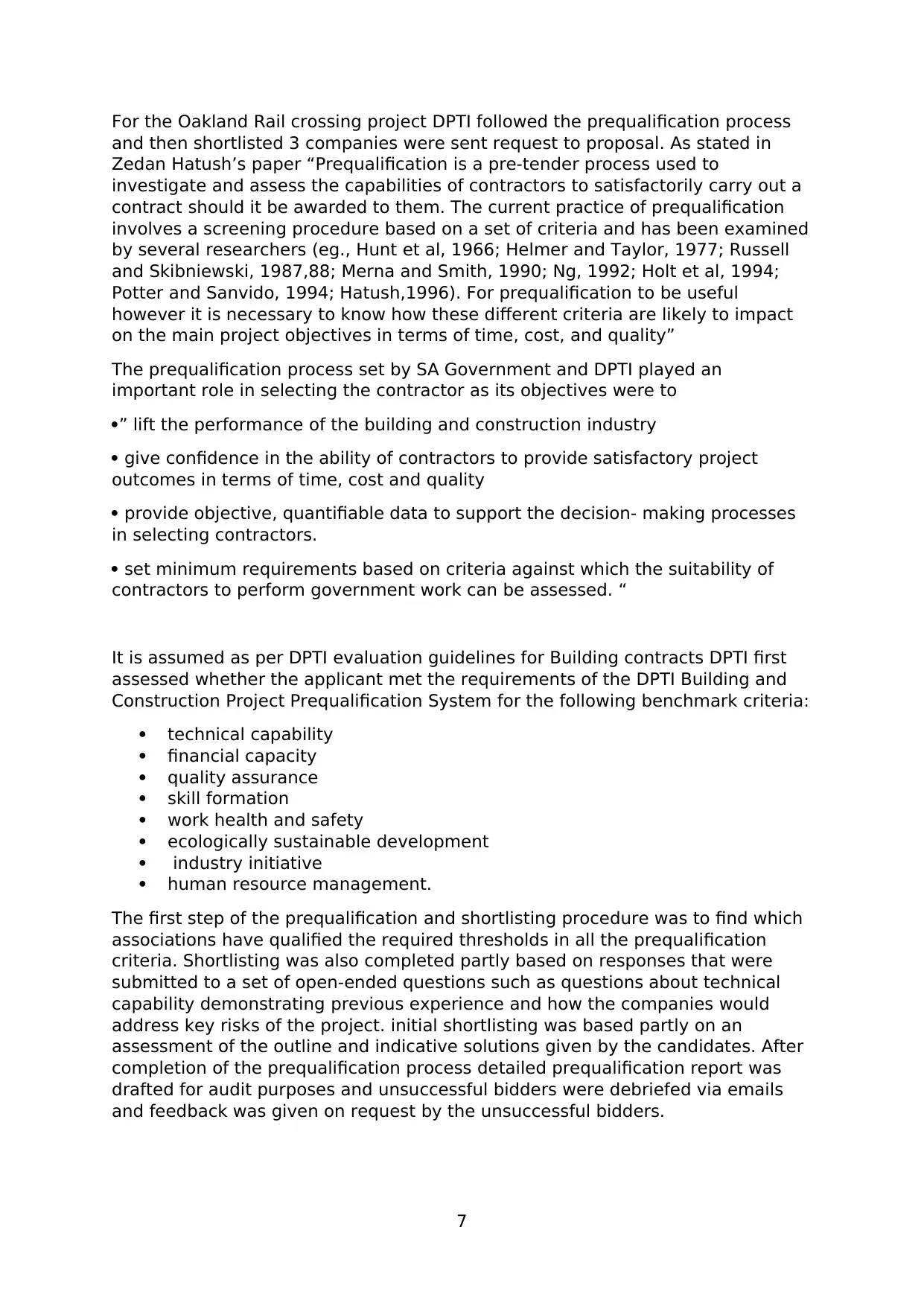
For the Oakland Rail crossing project DPTI followed the prequalification process
and then shortlisted 3 companies were sent request to proposal. As stated in
Zedan Hatush’s paper “Prequalification is a pre-tender process used to
investigate and assess the capabilities of contractors to satisfactorily carry out a
contract should it be awarded to them. The current practice of prequalification
involves a screening procedure based on a set of criteria and has been examined
by several researchers (eg., Hunt et al, 1966; Helmer and Taylor, 1977; Russell
and Skibniewski, 1987,88; Merna and Smith, 1990; Ng, 1992; Holt et al, 1994;
Potter and Sanvido, 1994; Hatush,1996). For prequalification to be useful
however it is necessary to know how these different criteria are likely to impact
on the main project objectives in terms of time, cost, and quality”
The prequalification process set by SA Government and DPTI played an
important role in selecting the contractor as its objectives were to
” lift the performance of the building and construction industry
give confidence in the ability of contractors to provide satisfactory project
outcomes in terms of time, cost and quality
provide objective, quantifiable data to support the decision- making processes
in selecting contractors.
set minimum requirements based on criteria against which the suitability of
contractors to perform government work can be assessed. “
It is assumed as per DPTI evaluation guidelines for Building contracts DPTI first
assessed whether the applicant met the requirements of the DPTI Building and
Construction Project Prequalification System for the following benchmark criteria:
technical capability
financial capacity
quality assurance
skill formation
work health and safety
ecologically sustainable development
industry initiative
human resource management.
The first step of the prequalification and shortlisting procedure was to find which
associations have qualified the required thresholds in all the prequalification
criteria. Shortlisting was also completed partly based on responses that were
submitted to a set of open-ended questions such as questions about technical
capability demonstrating previous experience and how the companies would
address key risks of the project. initial shortlisting was based partly on an
assessment of the outline and indicative solutions given by the candidates. After
completion of the prequalification process detailed prequalification report was
drafted for audit purposes and unsuccessful bidders were debriefed via emails
and feedback was given on request by the unsuccessful bidders.
7
and then shortlisted 3 companies were sent request to proposal. As stated in
Zedan Hatush’s paper “Prequalification is a pre-tender process used to
investigate and assess the capabilities of contractors to satisfactorily carry out a
contract should it be awarded to them. The current practice of prequalification
involves a screening procedure based on a set of criteria and has been examined
by several researchers (eg., Hunt et al, 1966; Helmer and Taylor, 1977; Russell
and Skibniewski, 1987,88; Merna and Smith, 1990; Ng, 1992; Holt et al, 1994;
Potter and Sanvido, 1994; Hatush,1996). For prequalification to be useful
however it is necessary to know how these different criteria are likely to impact
on the main project objectives in terms of time, cost, and quality”
The prequalification process set by SA Government and DPTI played an
important role in selecting the contractor as its objectives were to
” lift the performance of the building and construction industry
give confidence in the ability of contractors to provide satisfactory project
outcomes in terms of time, cost and quality
provide objective, quantifiable data to support the decision- making processes
in selecting contractors.
set minimum requirements based on criteria against which the suitability of
contractors to perform government work can be assessed. “
It is assumed as per DPTI evaluation guidelines for Building contracts DPTI first
assessed whether the applicant met the requirements of the DPTI Building and
Construction Project Prequalification System for the following benchmark criteria:
technical capability
financial capacity
quality assurance
skill formation
work health and safety
ecologically sustainable development
industry initiative
human resource management.
The first step of the prequalification and shortlisting procedure was to find which
associations have qualified the required thresholds in all the prequalification
criteria. Shortlisting was also completed partly based on responses that were
submitted to a set of open-ended questions such as questions about technical
capability demonstrating previous experience and how the companies would
address key risks of the project. initial shortlisting was based partly on an
assessment of the outline and indicative solutions given by the candidates. After
completion of the prequalification process detailed prequalification report was
drafted for audit purposes and unsuccessful bidders were debriefed via emails
and feedback was given on request by the unsuccessful bidders.
7
Paraphrase This Document
Need a fresh take? Get an instant paraphrase of this document with our AI Paraphraser
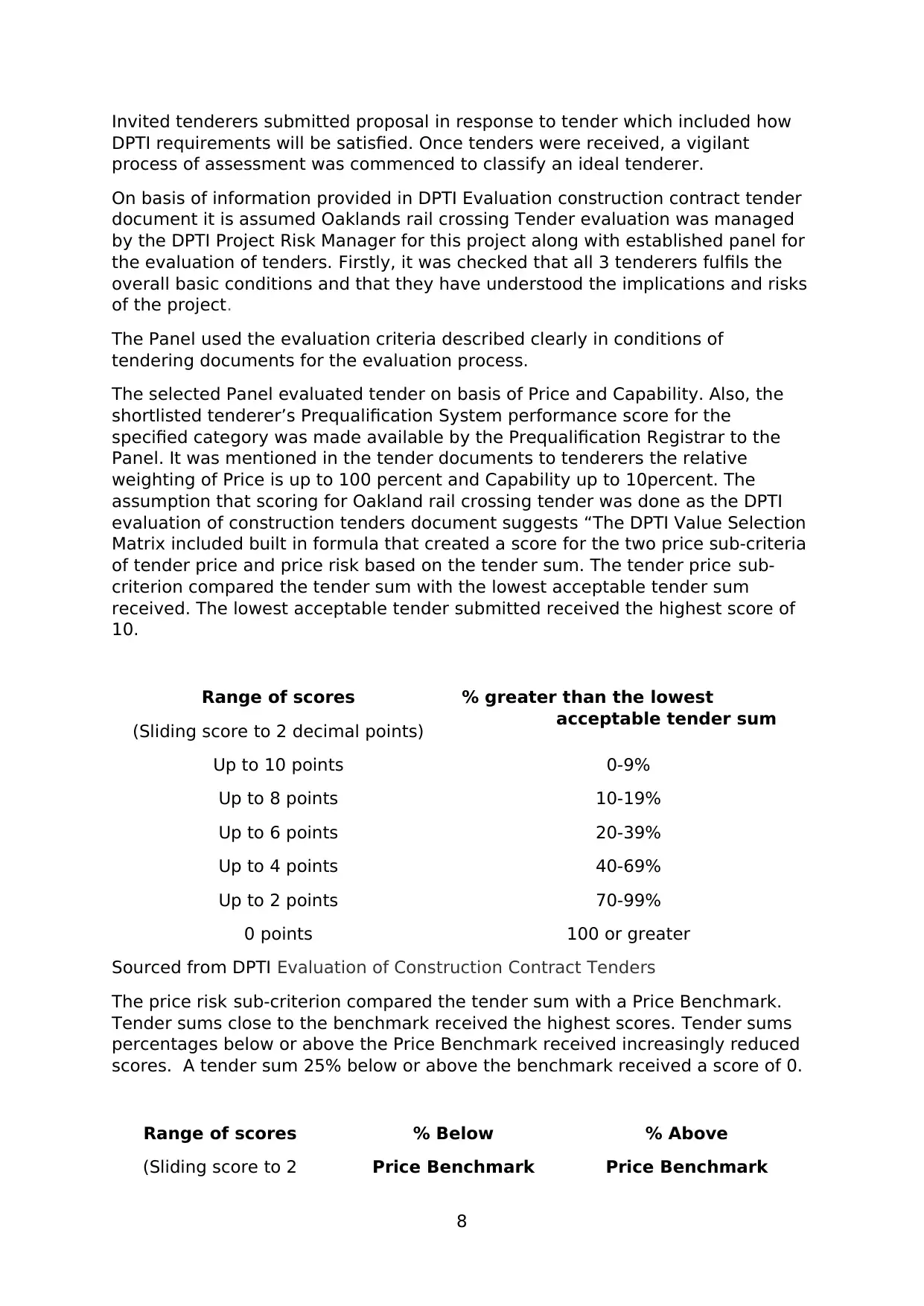
Invited tenderers submitted proposal in response to tender which included how
DPTI requirements will be satisfied. Once tenders were received, a vigilant
process of assessment was commenced to classify an ideal tenderer.
On basis of information provided in DPTI Evaluation construction contract tender
document it is assumed Oaklands rail crossing Tender evaluation was managed
by the DPTI Project Risk Manager for this project along with established panel for
the evaluation of tenders. Firstly, it was checked that all 3 tenderers fulfils the
overall basic conditions and that they have understood the implications and risks
of the project.
The Panel used the evaluation criteria described clearly in conditions of
tendering documents for the evaluation process.
The selected Panel evaluated tender on basis of Price and Capability. Also, the
shortlisted tenderer’s Prequalification System performance score for the
specified category was made available by the Prequalification Registrar to the
Panel. It was mentioned in the tender documents to tenderers the relative
weighting of Price is up to 100 percent and Capability up to 10percent. The
assumption that scoring for Oakland rail crossing tender was done as the DPTI
evaluation of construction tenders document suggests “The DPTI Value Selection
Matrix included built in formula that created a score for the two price sub-criteria
of tender price and price risk based on the tender sum. The tender price sub-
criterion compared the tender sum with the lowest acceptable tender sum
received. The lowest acceptable tender submitted received the highest score of
10.
Range of scores
(Sliding score to 2 decimal points)
% greater than the lowest
acceptable tender sum
Up to 10 points 0-9%
Up to 8 points 10-19%
Up to 6 points 20-39%
Up to 4 points 40-69%
Up to 2 points 70-99%
0 points 100 or greater
Sourced from DPTI Evaluation of Construction Contract Tenders
The price risk sub-criterion compared the tender sum with a Price Benchmark.
Tender sums close to the benchmark received the highest scores. Tender sums
percentages below or above the Price Benchmark received increasingly reduced
scores. A tender sum 25% below or above the benchmark received a score of 0.
Range of scores
(Sliding score to 2
% Below
Price Benchmark
% Above
Price Benchmark
8
DPTI requirements will be satisfied. Once tenders were received, a vigilant
process of assessment was commenced to classify an ideal tenderer.
On basis of information provided in DPTI Evaluation construction contract tender
document it is assumed Oaklands rail crossing Tender evaluation was managed
by the DPTI Project Risk Manager for this project along with established panel for
the evaluation of tenders. Firstly, it was checked that all 3 tenderers fulfils the
overall basic conditions and that they have understood the implications and risks
of the project.
The Panel used the evaluation criteria described clearly in conditions of
tendering documents for the evaluation process.
The selected Panel evaluated tender on basis of Price and Capability. Also, the
shortlisted tenderer’s Prequalification System performance score for the
specified category was made available by the Prequalification Registrar to the
Panel. It was mentioned in the tender documents to tenderers the relative
weighting of Price is up to 100 percent and Capability up to 10percent. The
assumption that scoring for Oakland rail crossing tender was done as the DPTI
evaluation of construction tenders document suggests “The DPTI Value Selection
Matrix included built in formula that created a score for the two price sub-criteria
of tender price and price risk based on the tender sum. The tender price sub-
criterion compared the tender sum with the lowest acceptable tender sum
received. The lowest acceptable tender submitted received the highest score of
10.
Range of scores
(Sliding score to 2 decimal points)
% greater than the lowest
acceptable tender sum
Up to 10 points 0-9%
Up to 8 points 10-19%
Up to 6 points 20-39%
Up to 4 points 40-69%
Up to 2 points 70-99%
0 points 100 or greater
Sourced from DPTI Evaluation of Construction Contract Tenders
The price risk sub-criterion compared the tender sum with a Price Benchmark.
Tender sums close to the benchmark received the highest scores. Tender sums
percentages below or above the Price Benchmark received increasingly reduced
scores. A tender sum 25% below or above the benchmark received a score of 0.
Range of scores
(Sliding score to 2
% Below
Price Benchmark
% Above
Price Benchmark
8
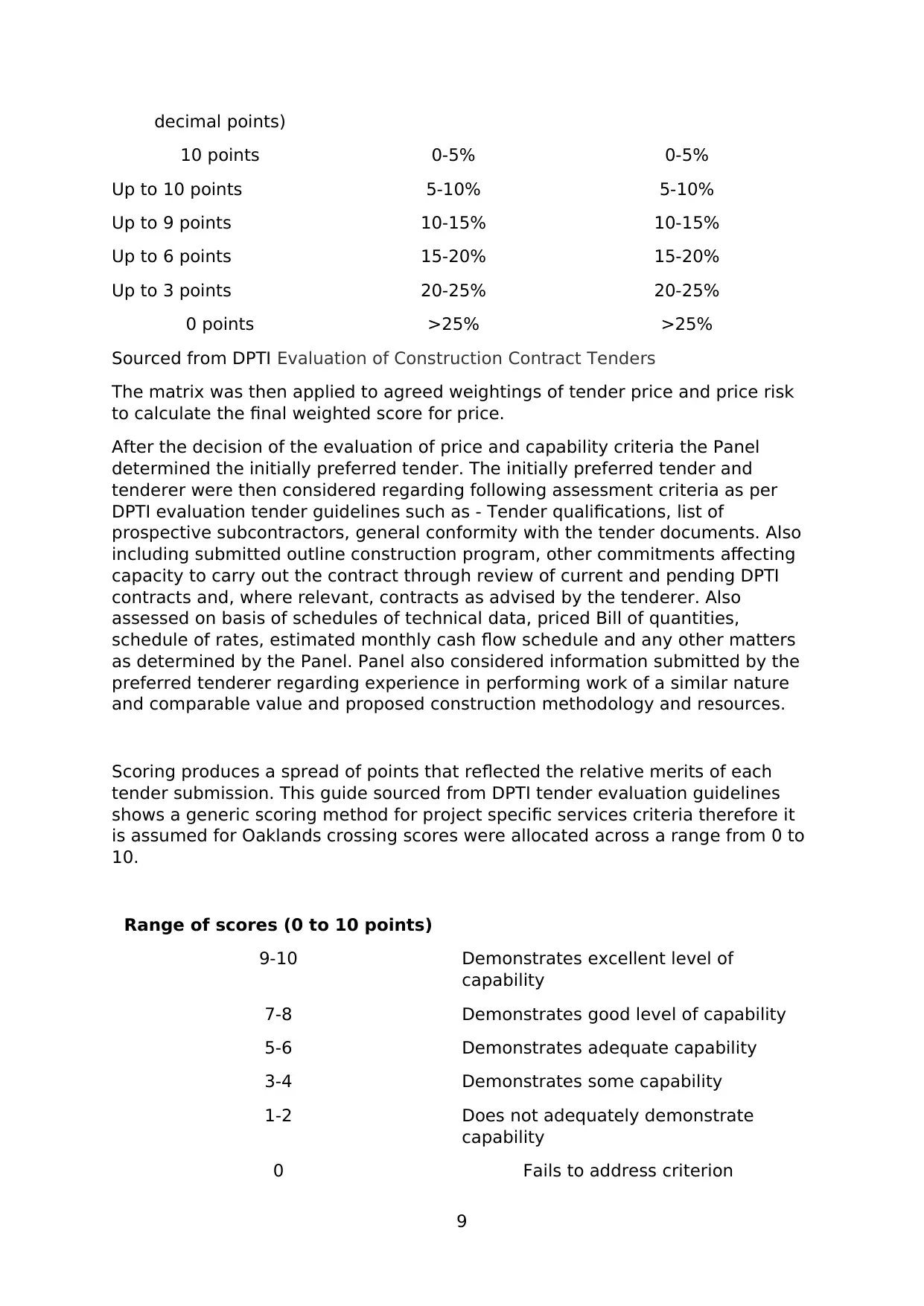
decimal points)
10 points 0-5% 0-5%
Up to 10 points 5-10% 5-10%
Up to 9 points 10-15% 10-15%
Up to 6 points 15-20% 15-20%
Up to 3 points 20-25% 20-25%
0 points >25% >25%
Sourced from DPTI Evaluation of Construction Contract Tenders
The matrix was then applied to agreed weightings of tender price and price risk
to calculate the final weighted score for price.
After the decision of the evaluation of price and capability criteria the Panel
determined the initially preferred tender. The initially preferred tender and
tenderer were then considered regarding following assessment criteria as per
DPTI evaluation tender guidelines such as - Tender qualifications, list of
prospective subcontractors, general conformity with the tender documents. Also
including submitted outline construction program, other commitments affecting
capacity to carry out the contract through review of current and pending DPTI
contracts and, where relevant, contracts as advised by the tenderer. Also
assessed on basis of schedules of technical data, priced Bill of quantities,
schedule of rates, estimated monthly cash flow schedule and any other matters
as determined by the Panel. Panel also considered information submitted by the
preferred tenderer regarding experience in performing work of a similar nature
and comparable value and proposed construction methodology and resources.
Scoring produces a spread of points that reflected the relative merits of each
tender submission. This guide sourced from DPTI tender evaluation guidelines
shows a generic scoring method for project specific services criteria therefore it
is assumed for Oaklands crossing scores were allocated across a range from 0 to
10.
Range of scores (0 to 10 points)
9-10 Demonstrates excellent level of
capability
7-8 Demonstrates good level of capability
5-6 Demonstrates adequate capability
3-4 Demonstrates some capability
1-2 Does not adequately demonstrate
capability
0 Fails to address criterion
9
10 points 0-5% 0-5%
Up to 10 points 5-10% 5-10%
Up to 9 points 10-15% 10-15%
Up to 6 points 15-20% 15-20%
Up to 3 points 20-25% 20-25%
0 points >25% >25%
Sourced from DPTI Evaluation of Construction Contract Tenders
The matrix was then applied to agreed weightings of tender price and price risk
to calculate the final weighted score for price.
After the decision of the evaluation of price and capability criteria the Panel
determined the initially preferred tender. The initially preferred tender and
tenderer were then considered regarding following assessment criteria as per
DPTI evaluation tender guidelines such as - Tender qualifications, list of
prospective subcontractors, general conformity with the tender documents. Also
including submitted outline construction program, other commitments affecting
capacity to carry out the contract through review of current and pending DPTI
contracts and, where relevant, contracts as advised by the tenderer. Also
assessed on basis of schedules of technical data, priced Bill of quantities,
schedule of rates, estimated monthly cash flow schedule and any other matters
as determined by the Panel. Panel also considered information submitted by the
preferred tenderer regarding experience in performing work of a similar nature
and comparable value and proposed construction methodology and resources.
Scoring produces a spread of points that reflected the relative merits of each
tender submission. This guide sourced from DPTI tender evaluation guidelines
shows a generic scoring method for project specific services criteria therefore it
is assumed for Oaklands crossing scores were allocated across a range from 0 to
10.
Range of scores (0 to 10 points)
9-10 Demonstrates excellent level of
capability
7-8 Demonstrates good level of capability
5-6 Demonstrates adequate capability
3-4 Demonstrates some capability
1-2 Does not adequately demonstrate
capability
0 Fails to address criterion
9
⊘ This is a preview!⊘
Do you want full access?
Subscribe today to unlock all pages.

Trusted by 1+ million students worldwide
1 out of 23
Your All-in-One AI-Powered Toolkit for Academic Success.
+13062052269
info@desklib.com
Available 24*7 on WhatsApp / Email
![[object Object]](/_next/static/media/star-bottom.7253800d.svg)
Unlock your academic potential
Copyright © 2020–2025 A2Z Services. All Rights Reserved. Developed and managed by ZUCOL.